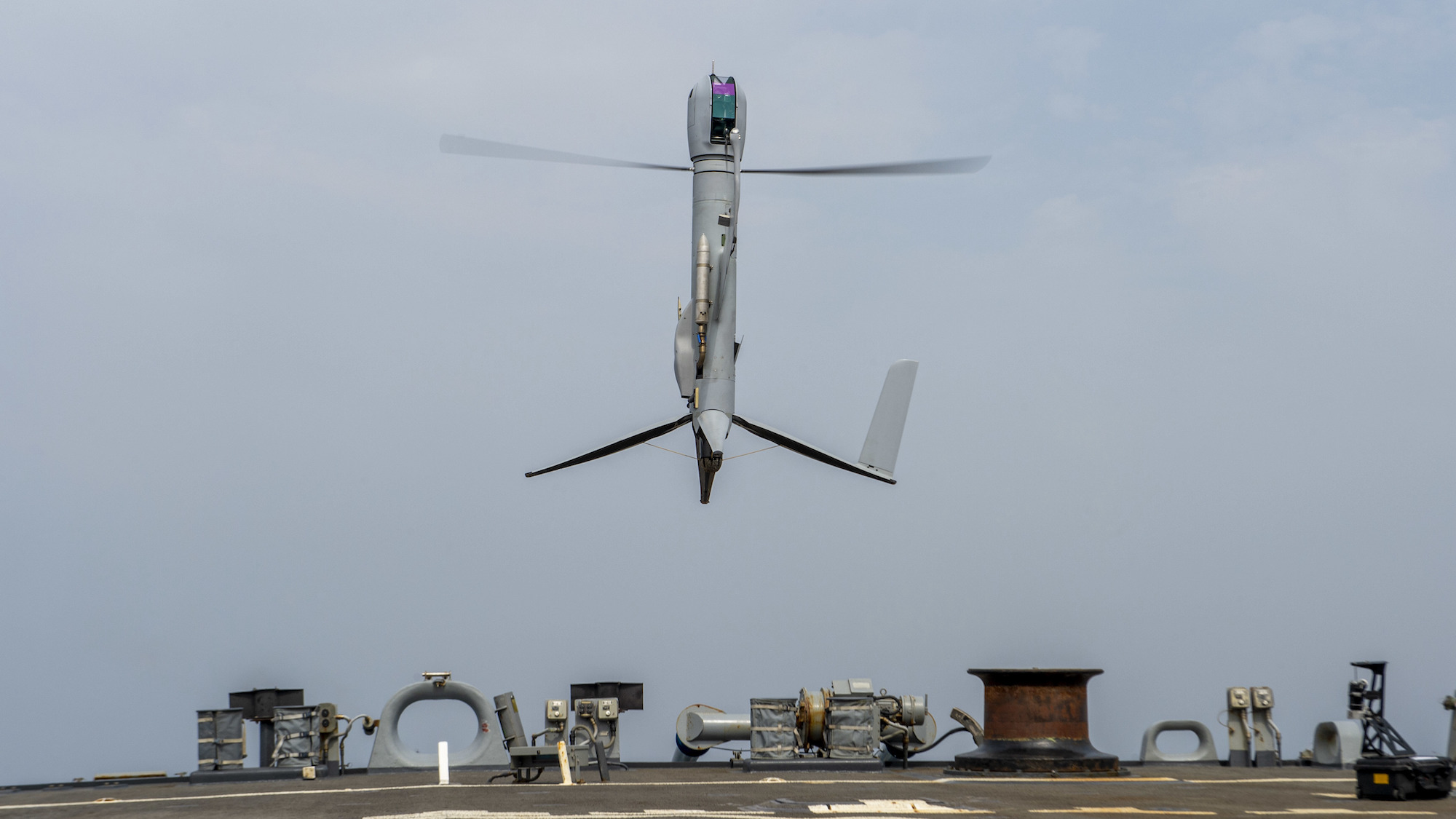

On March 8, in the ocean between Iran and the Arabian Peninsula, the US Navy tested out a new drone. Called the Aerovel Flexrotor, it rests on a splayed tail, and boasts a powerful rotor just below the neck of its bulbous front-facing camera pod. The tail-sitting drone needs very little deck space for takeoff or landing, and once in the sky, it pivots and flies like a typical fixed-wing plane. It joins a growing arsenal of tools that are especially useful in the confined launch zones of smaller ship decks or unimproved runways.
The March flights took place as part of the International Maritime Exercise 2023, billed as a multinational undertaking involving 7,000 people from across 50 nations. Activities in the exercise include working on following orders together, maritime patrol, countering naval mines, testing the integration of drones and artificial intelligence, and work related to global health. It is a hodgepodge of missions, capturing the multitude of tasks that navies can be called upon to perform.
This deployment is at least the second time the Flexrotor has been brought to the Persian Gulf by the US Navy. In December 2022, a Coast Guard ship operating as part of a Naval task force in the region launched a Flexrotor. This flight was part of an event called Digital Horizon, aimed at integrating drones and AI into Navy operations, and it included 10 systems not yet used in the region.
“The Flexrotor can support intelligence, surveillance and reconnaissance (ISR) missions day and night using a daylight or infrared camera to provide a real-time video feed,” read a 2022 release from US Central Command. The release continued: “In addition to providing ISR capability, UAVs like the Flexrotor enable Task Force 59 to enhance a resilient communications network used by unmanned systems to relay video footage, pictures and other data to command centers ashore and at sea.”
Putting drones on ships is hardly new. ScanEagles, a scout-drone used by the US Navy since 2005, can be launched from a rail and landed by net or skyhook. What sets the Flexrotor apart is not that it is a drone on a ship, but the fact that it requires a minimum of infrastructure to make it usable. This is because the drone is a tail-sitter.
What is a tail-sitter?
There are two basic ways to move a heavier-than-air vehicle from the ground to the sky: generate lift from spinning rotors, or generate lift from forward thrust and fixed wings. Helicopters have many advantages, needing only landing pads instead of runways, and they can easily hover in flight. But helicopters’ aerodynamics limit cruising and maximum speeds, even as advances continue to be made.
Fixed wings, in turn, need to build speed and lift off on runways, or find another way to get into the sky. For rail-launched drones like the ScanEagle, this is done with a rail, though other methods have been explored.
Between helicopters and fixed-wing craft sit tiltrotors and jump-jets, where the the thrust (from either rotors/propellers or ducted jets) changes as the plane stays level in flight, allowing vertical landings and short takeoffs. This is part of what DARPA is exploring through the SPRINT program.
Tail-sitters, instead, involve the entire plane pivoting in flight. In effect, they look almost like a rocket upon launch, narrow bodies pointed to pierce the sky, before leveling out in flight and letting the efficiency of lift from fixed wings extend flight time and range. (Remember the space shuttle? It was positioned like a tail-sitter when it blasted off, but landed like an airplane, albeit without engines.) Early tail-sitters suffered because they had to accommodate a human pilot through all those transitions. Modern tail-sitter drones, like the Flexrotor or Australia’s STRIX, instead have human operators guiding the craft remotely from a control station. Another example is Bell’s APT 70.
The advantage to a tail-sitting drone is that it only needs a clearing or open deck space as large as its widest dimension. In the case of the Flexrotor, that means a rotor diameter of 7.2 feet, with at least one part of the launching surface wide enough for the drone’s nearly 10-foot wingspan. By contrast, the Seahawk helicopters used by the US Navy have a rotor diameter of over 53 feet. Ships that can already accommodate helicopters can likely easily add tail-sitter drones, and ships that couldn’t possibly fit a full-sized crewed helicopter might be able to take on and operate a drone scout.
In use, the Flexrotor boasts a cruising speed of 53 mph, a top speed of 87 mph, and potentially more than 30 hours of continuous operation. After takeoff, the Flexrotor pivots to fixed-wing flight, and the splayed tail retracts into a normal tail shape, allowing the craft to operate like a regular fixed-wing plane in the sky. Long endurance drones like these allow crews to pilot them in shifts, reducing pilot fatigue without having to land the drone to switch operators. Aerovel claims that Flexrotors have a range of over 1,265 miles at cruising speeds. In the air, the drone can serve as a scout with daylight and infrared cameras, and it can also work as a communications relay node, especially valuable if fleets are dispersed and other communications are limited.
As the Navy looks to expand what it can see and respond to, adding scouts that can be stowed away and then launched from cleared deck space expands the perception of ships. By improving scouting on the ocean, the drones make the vastness of the sea a little more knowable.
Watch a video below:
